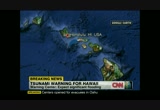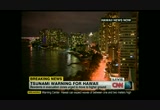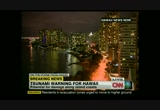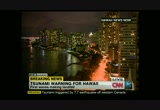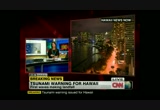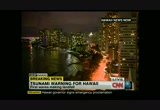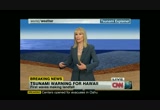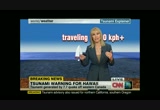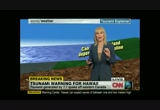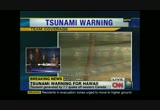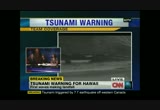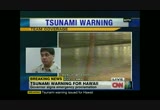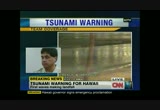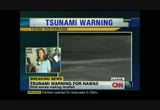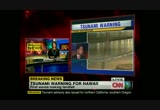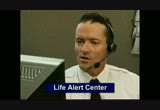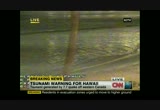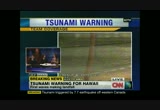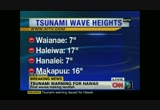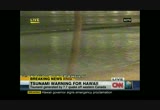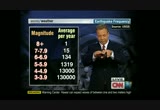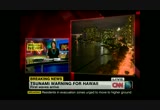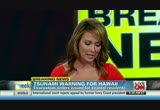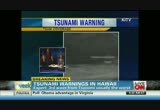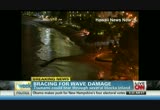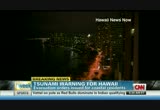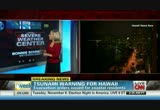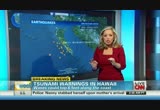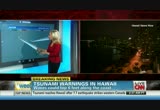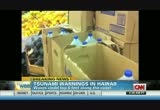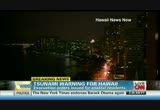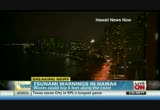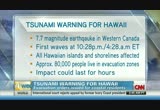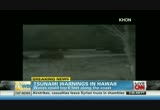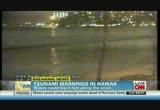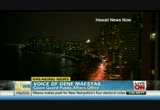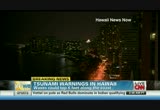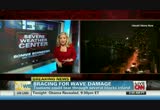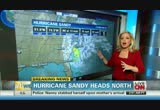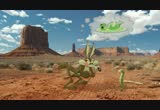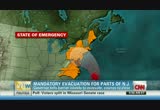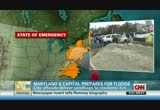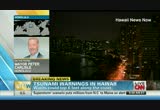tv According to Lance CNN October 28, 2012 2:00am-3:00am PDT
2:00 am
get protected now. call the number on your screen or go to lifelock.com to try lifelock protection risk free for a full 60 days. use promo code: gethelp. plus get this document shredder free-- but only if you act right now. call the number on your screen now! -- captions by vitac -- www.vitac.com natalie allen at cnn center. we are keeping a close eye on all of the islands of hawaii which right now could be experiencing a series of tsunami waves generated by an earthquake that occurred on the western edge of canada. the folks in hawaii had one hour of sirens telling them that they were in the direct line to see a tsunami this evening. it is 11:00 p.m. in hawaii.
2:01 am
a lot of folks except for reporters have left the shores. they're expecting, perhaps, waves one to two meters. we just did hear from the pacific tsunami warning center that all indications from tide gauges are that there is a tsunami moving in, but not big at this point. and he said there could be a situation where throughout the hours they could see waves that get bigger. but many people just waiting in hotels or have moved to evacuation centers in hawaii waiting to see what this tsunami brings. they've been told, some people that were stuck in their cars just a short while ago, about 45 minutes before this tsunami was expected to arrive, the police were telling them just get out of your car and start walking to higher ground just in case to be safe. this has been a little bit of a surprise for the folks there in
2:02 am
hawaii on a busy saturday evening. and unusual that hawaii takes -- is in the direct line for tsunami all the way from the eastern pacific. we've been talking with people who are running hotels. officials there working the story. and we also have one of our cnn producers who does happen to be on vacation in hawaii. seems like there is always one there where we need them. that is oggie martin. you're on the big island safe in your hotel. you've been up on the roof with a good sign from the beach. are you seeing anything? >> no. not a whole lot. i will say there was about probably 10 or 15 minutes ago a little bit of a discernible change in the way the surf was coming ashore on this beach. it's been fairly robust all day. it actually calmed down for probably about five minutes.
2:03 am
it almost appeared to be sort of the opposite effect of what one might envision with a tsunami coming ashore. i can't be sure that it was. the behavior of the water definitely changed a little bit in that it actually calmed down for probably five or six minutes. >> well, we heard from a gentleman, victor sardino with the stsunami warning center saying that's what you would see. you would see it come in and see it pull back. then because they expect a series of waves that you might be seeing that repeated throughout the evening. but still i would assume no one on the beaches there and everyone is staying at a certain level at the hotel? what's the level guests have to be at? >> yeah. they said earlier that if you were on the fourth floor -- i think it was the fourth floor or above you were fine. and, indeed, there isn't anyone on this beach here. it's a nice wide beach. one of the more spectacular
2:04 am
beaches in the state. but because, you know, the surf was fairly robust today, you know, i'm not sure what -- what level this tsunami would have to rise to to really be very obvious to the naked eye. it is a very deep beach. but, yes. aside from the surf just calming down for a little while, i haven't seen anything terribly obvious that would point to sort of typical tsunami. >> about how many feet is your hotel from the surf? >> oh, it's right on the beach. it's right on the beach. my vantage point is eight stories above the beach. like i said earlier, it's a nice nearly full moon here. so visibility is pretty good, pretty optimal, in fact. but we wait and see if anything changes. >> what's the atmosphere as far as the guests and the vacationers there in your hotel
2:05 am
regarding this situation there this evening? >> it's fairly calm and orderly. occasionally some -- a couple or two will pop their heads up on the roof here and take a gander at the beach. but, you know, everybody seems very relaxed and almost curious at what may be coming our way. there doesn't seem to be an overwhelming sense of fear or panic. it's almost more intrigue than any of those things. >> well, hopefully nothing will happen to cause anything more than intrigue or curiosity there in hawaii. how are you told as far as monitoring local news and the guidance that you're getting from the hotel? when will people know that they're out of harm's way? will the warning be lifted? how does that happen? have you heard? >> i think everybody's relying first and foremost on the hawaii civil defense and local media. the hotel here specifically said
2:06 am
that if things got worse, they would come on loud speakers and the volume of the tsunami sirens would increase to a higher level than they have been. but for the most part everybody here is watching local tv stations and listening to local radio for their information. >> earlier you told us, augie, there were some aircraft flying in the area and some law enforcement vehicles, cars flashing. are you still seeing that? s >> yes. yes, indeed. there are lots of law enforcement out stationed on the highways it appears from my vantage point. and there have been probably two or three aircraft that have flown over this part of the coast here with their -- their light beams shining down on the coast and blaring sirens as they
2:07 am
fly by. i haven't seen one in 20 minutes or so. there does seem to be good law enforcement presence here. >> we appreciate it again. cnn's augie martin there on the big island describing a scene where people are just mainly curious about what's going on. we hope that they have no reason for any fear this evening with this tsunami. let's go get the latest now on the warnings that we're hearing as far as the waves coming ashore, what they've predicted could happen as we see this live picture from station -- the news -- hawaii news now that you can see the waves there on the beach of waikiki beach. what are the predictions? >> natalie, the prediction was -- this would -- we would see the first hint of a tsunami or wavie ins being generated 10
2:08 am
local time in hie hie. we don't see anything that looks ominous definitely right now. there was a warning for this area. as opposed to the coast of british columbia where we had seen an advisory. why were they in advisory and hawaii was a warning? well, british columbia, we can come back to me, they are the closest to the epicenter of this earthquake. as a result, the waves don't have a long way to travel, so they're not going to pick up that energy. they're not going to have the force as opposed to traveling all across the pacific basin. essentially as far as tsunamis go, when you have a subduction zone, meaning you get those plates, one going underneath the other or slipping, which is kind of a combination of both, then that sends the energy out over the water. if you were on the ocean waters you really wouldn't feel anything. even though those waves were traveling in excess of 800
2:09 am
kilometers per hour in some cases. so 400 or 500 miles per hour. but as the water gets shallower and moves closer to shore, then all of that energy is just going to build up and release. well, for hawaii, they were expecting about a meter to two plus meters or so, a tsunami. so we're looking at three to seven feet is what we had anticipated originally. this, the kind of cause and effect from the 7.7 earthquake, right around the central british columbia coast, and that is a logging area. it's forestry. it's not very well populated at all. it's very sparsely populated. but you can guarantee there would be people right there who definitely would have felt that. but because it's so sparsely populated, we're not hearing a lot of people call in and say
2:10 am
that they felt it. there have been aftershocks. just about a dozen or so since this initially occurred. most of those aftershocks, natalie, have been along the 4 and 5 magnitude. nothing like the 7.7 magnitude. back in 1947 they had an 8.1. almost exactly in the same area. this particular one, the 7.7 one that just occurred, was reasonably shallow. i would say moderately shallow. just about 17 kilometers deep. the initial report, natalie, was it was about ten kilometers deep. so that's fairly shallow. but it triggered the warning systems to go off. that's why the people in hawaii said we're going to issue a warning, a tsunami warning. >> that's what we're waiting to see right now to see if this does, indeed, generate the waves that they have predicted. we're going to listen in -- thank you, karen -- just for a
2:11 am
moment with one of our affiliates to hear their coverage, hawaii news now. let's listen. >> they're typically watching. so right now that third wave coming in. we expect to get a little more information. typically it's after about the third or fourth wave they start to update civil defense and whatnot as to whether or not they can downgrade the threat. so we'll see. we might have some more information in another 20 minutes or so as to when they may possibly downgrade their warning here. that third wave coming in. i'll send it back to you guys. >> thank you, laura. thank you so much for being down there and passing that information down to us. so far, so good, then with that 1 1/2 -- >> now we've seen the second wave. we'll be waiting for the third and fourth waves. that is good news. 20-minute cycles a waiting game. so far it seems like we're seeing consistent levels of those wave levels you read earlier throughout the island. >> let's just hope it stays -- the highest reporting from the first wave, about a foot and a half. highest reporting of the second wave about a foot and a half.
2:12 am
normally the third and fourth wave is the largest. hopefully that's on the lower end of maybe, like, three feet. >> ryan talked about -- ryan, from the big island, reminded us that that big six-foot wave that hit in the kona area was hours later. so what -- the big island is one of the key spots we're looking at as well. >> so far the big island wave heights have actually been on the lower end as compared to other locations. >> we want to head over to cam tran at ems with an update. >> hey there, guys. we are with john cummings with the department of emergency management. he's here to explain the process of the all clear. i know it's early on. just to let people at home know, what is the process? >> right now, of course, we're waiting to see what's going to
2:13 am
happen. we're not out of this yet. we're still in a warning. we're still anticipating a destructive sue ma'tsunami even. at a certain point they'll tell us, hey, yeah, it looks like the destructive energy is past the island. this could be pretty far off. once they give us that information what will happen is our mayor will instruct our first responders to go down to the shoreline and to give us an eyeball of what's happening. because we need a ground crew with the information from the warning center. what that all means is basically they're going to feed the information back here. the official word for an all clear will come from our mayor as it would come from all other county mayors. we're pretty far away from that now. that is the process. >> have you heard anything from the pacific tsunami center yet? >> no. they're sitting and watching as we are right now. we're looking at video feeds as you folks are now from the shoreline. they're looking at scientific data and sharing information with us. we're online right now with all of the counties.
2:14 am
we have an open line. we can immediately know if an island, outside in other county, has some type of impact. that's going to affect everyone. >> will the counties make the decision all at the same time, then? >> no, it depends. as you notice each county went into evacuation phase a little bit differently. because it depends where the energy's coming from. kaw right now we're just -- again, we're way away from any type of all clear. we're just waiting to see what's going to happen. we're in forward mode. leaning forward in our fox holes and waiting to see if something does happen we'll have to go at some point into rescue and recovery and emergency response mode. >> all right. let's go to pacific tsunami warning center. i think we've got laura there.
2:15 am
>> we're talking to one of the gsis who's keeping an eye on some of the information from the title gauges. he has some information based on the third wave that's coming in. and basically they're saying -- i'm going to walk a little closer to him now. basically they're saying it's generally lower in most areas than they expected initially. the highest so far. they still have a couple more cycles they want to get through before they really start looking as to whether or not they can start to reduce the risk that's out there. even though as we've been talking about through the evening things can change ba. we're getting hard facts, hard data. it's generally showing everything's a little bit lower than they initially expected. really good news for everyone out there. it's still going to be a pretty long night out here.
2:16 am
i'll send it back to you guys. >> justin, we wanted to put it into inches versus feet or meters. i think it's a little easier to understand. >> largest wave so far, again, as laura just mentioned, almost two feet. 23 inches at kahului. >> we've been listening to our affiliate kitv bringing us some good information and welcome information that the waves that they've seen so far from the tsunami warning smaller than anticipated, about a foot and a half. they're expecting two more waves to come in. they're still monitoring to see what situation all of these islands will see in hawaii tonight with this tsunami generated from the earthquake in canada. but so far, so good on what they are seeing. not as severe. but, again, they're still under a tsunami threat. no one's going anywhere. we'll continue to follow the story. we'll take a quick break. we'll have more for you right after this. hat's more beautiful than a covergirl? two covergirls.
2:17 am
get two miracles in one product. tone rehab 2-in-1 foundation. covers spots, lines, and wrinkles. and helps improve skin tone over time. tone rehab from easy, breezy, beautiful, covergirl! covergirl! ♪ atmix of energies.ve the world needs a broader that's why we're supplying natural gas to generate cleaner electricity... that has around 50% fewer co2 emissions than coal. and it's also why, with our partner in brazil, shell is producing ethanol - a biofuel made from renewable sugarcane. >>a minute, mom! let's broaden the world's energy mix. let's go.
2:19 am
hello again from cnn center. i'm natalie allen. we're monitoring a story out of hawaii with tsunami waves coming ashore right now. not as big as they anticipated. that's the good news. still coming ashore. let's get the latest from the pacific tsunami warning center. gerard fryer has been giving people an update. >> the mistake we made would be japan's tsunami was that we were just looking at those 13 points. they didn't tell us what was happening other places. and we actually canceled a little bit too early. >> that is something that you've been talking about throughout the evening. that even though the waves that are coming in are going down, you still have that concern within the islands and the energy that's generated that
2:20 am
way, that just created all those variations in the bays and the different islands the last time. is that correct? >> yeah. i mean, this tsunami -- there's no question. this tsunami is big enough to generate troublesome currents. fortunately, it's the middle of the night. i don't think many people are going to go swimming. if they did, they would get into difficulties, no question. and we're told of another sign out in california that based of off that there's a little more optimism. you're seeing the trends are basically what you guys have predicted. is that fair to say? >> it's a little too early. we really need to wait for another wave. excuse me. i have to go back. >> that was gerard fryer from the pacific stsunami warning center. no surprise he was pulled back. they're trying to gauge as best they can as to when they can reach the point of downgrading. it's not going to happen right away. they still have at least a couple more cycles that they have to go through before they
2:21 am
feel like they've reached the peak of some of these waves coming in. again, as we've been mentioning, everything that's going to happen within the islands as well because of the energy generated that way. it's still going to take a little bit longer. all in all they're seeing levels a little bit lower. hopefully within the next couple of cycles, maybe an hour or two, we can get some concrete information as to when they may move to reducing the warning level out there. i'll go ahead and send it back to you guys. >> thanks so much, laura. you know what's interesting, he said it's a good thing it happened at night. i know for evacuations that makes it tough. he said it's good because the currents can be a danger for swimmers. this is a blessing it happened when it's dark outside. hopefully no one out there in those waters. >> it's good timing. he said they feel maybe the forecast was an overprediction. but you'll never know till it's
2:22 am
finished what was going to happen. overprediction is better than an underprediction. >> dr. fryer made a good point about dropping the tsunami island too early. after it was dropped is when we had all those problems in coeko. folks, we're only in our fourth wave. these things could go on 10, 15, 20 waves. so far, so good. of the first three waves so far we've got wave heights here. the largest we've seen so far coming in seven inches in waianae. 17 in haleiwa. topping the list, 23 inches at kahului harbor. actually 30 inches now. yeah. all in all, it's big enough to cause problems in the harbors. maybe strong currents. not quite big enough to cause
2:23 am
destruction or problems on shore. this is what we're going to continue to see all night long. but it looks like it may have been an overprediction of three feet to seven feet. >> katherine cruz has been out there in waikiki. you've been looking at the water. seeing any changes at all? >> actually i was upstairs after i hung up with you. i went upstairs. we were watching from the second floor and didn't see much. a lot of tourists actually moved back and went back in, i guess, to their hotels when they didn't see any waves out there on the beach. i'm actually up here by waikiki elementary school where there are about a dozen police officers lined up. all the police cars are lined up along paki avenue. a lot of these officers are actually from the waikiki substation. that place is all locked down. all the the first responders have moved back. this is where everybody's staging, waiting for the all
2:24 am
clear. i did actually talk to a couple of homeless people who were on the beach. they heard the sirens. and they packed up all their things and moved up to higher ground. >> all right. kitv's coverage there in hawaii. tsunami warnings still going on. they've seen four waves. about a foot and a half, not the three to six feet waves that they had predicted. that's the good news. but it's been an interesting night for the folks there in hawaii who live there and all the tourists who are there. big party weekend in hawaii. saturday night before halloween. one party had 15,000 people near the beach. they had to get up and get out of the way. everyone had one hour to evacuate and get to higher ground just in case this tsunami did generate the waves that they had predicted. so they still expect more waves to come in. they're continuing to monitor it there at the pacific tsunami warning center before they release this morning because they did that earlier one time
2:25 am
and they still had some trouble at some outlying islands. all of hawaii under threat from this tsunami. let's go to our meteorologist, tom seder at the world weather center. if people are just joining us, tom, they might be interested why hawaii was a dead on target from an earthquake that happened on the -- just outside western canada's shore. >> yeah, right? in fact, this is an area known for its earthquakes. in the last 40 years there have been seven quakes that have registered 6.0 or greater. now, you've got to go back 1949 to find a quake much larger at 8.1. that was just 100 kilometers to the northwest of this site. of course, take a look at what we're talking about. this is a 7.7. the depth is not extremely shallow but not very deep at all. however, we've got to take a closer look at this area to really see the history and why the tsunami wasn't as large. maybe why it was nowhere near what they had in japan.
2:26 am
let's talk about first of what we talk about when we talk about the magnitude and how many of these of this side occur. between 7.0 and 7.9 this is a major earthquake. there is major shaking. i'll talk more about the region for you in just a moment. we only have 15 of these a year across the entire globe. let me show you on our earth image here of where this area is. we'll talk about the techtonic plates involved. we have the pacific plate. the techtonic plate and the north american plate. it wasn't a total subduction where one plate falls quickly below the other. this was called what we call an oblique thrust. there was some dsubduction whic causes a rise in the water but there's also a parallel shift. unlike fukushima when we had the large tsunami, an incredible thrust. for the most part as we talked about this was relatively shallow at 17 kilometers. there was a lot of shaking going
2:27 am
on. but to give you an idea, this area off british columbia is not inhabited. it's forestland. there's a lot of forest industry there. again, we don't have a shake map that's going to resemble much in the way of damage to the local area. but being so far away, talking about, natalie, the sensors that are used in the ocean, so really detect the energy put a spike directly from british columbia toward the hawaiian islands. >> very interesting. thanks so much, tom. a few more seconds to go here before we take a quick break. just want to let you know that all okay in hawaii so far as these waves start to move ashore. four have come ashore. just a foot and a half so far. we'll continue to monitor it and be right back. [ female announcer ] introducing yoplait greek 100.
2:28 am
2:29 am
for a golf getaway. double miles you can actually use... but mr. single miles can't join his friends because he's getting hit with blackouts. shame on you. now he's stuck in a miniature nightmare. oh, thank you. but, with the capital one venture card... you can fly any airline, any flight, any time. double miles you can actually use. what's in your wallet? alec jr? it was a gift. [ male announcer ] why do more emergency workers everywhere trust duracell...?? duralock power preserve. locks in power for up to 10 years in storage. now...guaranteed. duracell with duralock. trusted everywhere.
2:30 am
good morning to you. it is 5:30 on the east coast. i'm brooke baldwin sitting in for randi kaye. we wanted to come to you early. quite the busy sunday morning. let me bring you up to speed. breaking news here this morning. magnitude 7.7 earthquake hit off the western coast of canada. we're talking about the area around the queen charlotte islands, just to give you some perspective as to where this thing began. because we're going to be talking this morning a lot about
2:31 am
the stsunami and ripple effect and how this is affecting hawaii. as far as hawaii is concerned because of this earthquake just off bc evacuation orders have been issued. as a result of that, emergency sirens have been blaring across parts of hawaii. just take a look at some of these pictures here. we're working with a couple different pictures. we'll look now at this beach area. as we look at these pictures in just a moment here, and here you have it looks like maybe one of these local reports. we're watching some of the local reports out of hawaii. you can see some of the waves coming in. keep this in mind. if you think of that whole hollywood mentality of that huge, huge first wave coming in to hit hawaii, that's not -- that's not the case here. experts say it's actually the succession of large waves that could be hitting the island. we've been watching overnight here, and we should be hearing somewhere between three and seven feet waves that could be slamming into the island for
2:32 am
several hours. so forgive me if i just talk live. okay. let's go ahead and get -- let's get john cummings. john cummings is the public information officer for the honolulu emergency management center. john cummings, this is brooke in atlanta. i know it's been a busy, busy night for you all. can you just bring me up to speed, what are you seeing now as far as waves are concerned. >> well, you know, right now on the island of oahu, we've been into this for about an hour now. nothing sizable. again, tsunamis are a fickle science. there could be something on the horizon we can't see yet that could impact us. until the tsunami warning center lets us know definitely we are out of this, we're still in a warning, still in evacuation. could be hazardous situations. >> i'm hearing a couple voices in my ear. john, are you still with me? >> yes, i am. >> okay. help us understand, when we're looking at these different waves
2:33 am
and we're looking at the succession of waves, how high are the waves that you've seen so far? let's call it a worst wave, what a worst wave might look like? >> you know, the worst wave could be a slow success where the water completely pulls away from the shoreline. the first wave could be where a huge wave comes in. it just really depends. it's hard to know when waves are going to arrive. what we don't know is really how big they're going to be until they're on the shoreline. >> okay. as we're looking again at these pictures, i believe these are pictures from honolulu. tell me, you're there. gauge the concern level for me. i know this is the kind of thing if you live in hawaii and perhaps you hear tsunami warnings you grow sort of accustomed to that. how is concern right now for you? >> you know, concern is very high both for our folks here in emergency management and
2:34 am
especially our residents who not only had to evacuate but have had to camp out some place. maybe at a friend's house. maybe at a park some place or refuge center. we're all very concerned. we have a history of tsunami events impacting us going over the last, you know, 60-plus years. on oahu here we had six people die in 1946. the hazard is there. we treat this as a very destructive and dangerous situation. >> okay. john cummings, we appreciate it. we're going to be checking back in with you here through the morning as we continue to watch here the tsunami warning for hawaii, watching those waves. we've got a number of people we're going to talk to. people who live there. again, evacuations in place. and we have bonnie snyder who is standing here with me in the studio on this early sunday talking about the tsunami. we just heard -- we heard john cummings tell me, you know, look. this is something that folks in hawaii are accustomed to dealing with. but this is certainly on a weekend that is the weekend before halloween when you have all these revelers out and about
2:35 am
creating quite a mess, i know, on some of these coastal roads trying to come inland. not the best situation. >> not at all. the one thing was it was at night. had it been during the day there would be even more people on the beach and more people in danger. when there is a tsunami warning the most important thing to do is to get to higher ground. whether you're in a hotel or whether you're on the beach. you want to get off the beach. you know, i've studied tsunamis. i know a lot of people are attracted to going to the beach to see them come in. it's the worst thing that you can do. you want to get to that higher ground. when you're talking about a tsunami, you're talking not just about a wave. you're talking about a series of waves that come in. and often it's the second, third or even fourth wave that could be stronger. so it's not an event that just happens once and then it's otve. the water pulls that, takes everything with it and comes in again. luckily so far the initial reports we're getting, the waves could have been a lot higher. they actually were pretickdicte
2:36 am
be higher than what they were. keep in mind it's not over till the warning is discontinued. we're looking at a radar picture of hawaii. see various islands here as well. this earthquake was so far away, but it was a strong one. look at the magnitude. 7.7. way up in canada. it just goes to show you how the energy can work its way across the ocean from an earthquake. you know, tsunamis are caused by three factors. landslides, volcanos and earthquakes. they happen deep in the ocean floor. it could be a very slight and subtle movement. but there's a displacion of the water. the deeper the water, the less you'll feel the tsunami. you could be out on the open water of the ocean and not feel a thing. once the water builds and bubbles toward the shoreline, it can grow and generate waves. that's the concern right now for hawaii. >> bonnie, listening to one of these officials at the pacific tsunami warning center and as
2:37 am
they're anticipating these waves maybe as tall as six feet, perhaps in the three or four foot range, a reporter was asking what would the damage do? he was saying, look, it wouldn't definitely destroy any buildings. but when you look at the coast of beautiful hawaii most definitely it would flood a number of blocks into these islands. to we know yet which island would be hit first? >> it depends on where -- you know, where the wave comes -- where the wave is coming in. we've had some reports of some of the higher amounts in some of the central islands. it's difficult to tell because topography comes into the picture. not just where the islands are located but the shallow depth of the island also. you mentioned possible flooding. remember, a lot of people in hawaii are in their cars, especially at night, and they're close to the water. that's where they want to be. that's what makes it so dangerous.
2:38 am
it only takes a few inches of water to dislocate or dislodge even an suv. even a few inches can be very dangerous if you're in your car. >> to your point, do not head to the coast to take a look. go the other direction. bonnie schneider, we'll be coming back to you many, many times this morning. i appreciate it. first let me show you, this is happening right now. we're getting bits and pieces of video i want to pass along to you. first you can see here these are -- you can hear her talking about the supermarket here. so people are headed to the supermarket trying to, you know, grab some fruits and veggies and water, of course. they don't know how long they may be at home. also lining at the gas station. people trying to grab gas when they can. as they know that the tsunami is coming. you can see here traffic already backed up because they want to do precisely that. because they want to get gas. finally, we've been talking here what happens -- you hear this? let me pause so you can hear what a warning siren sounds
2:39 am
like. [ siren ] so this is what a lot of people in hawaii on their saturday night were hearing. when you live in hawaii, you know exactly what that means. that is a tsunami warning. that means get away from the coastal regions and head inland. i want to head to one of the hotels to robert repas. not only are people living here in hawaii. many, many people, the fortunate ones that are on vacation, and robert repas actually lives there. robert, can you hear me? this is brooke in atlanta. good morning. >> good morning. >> good evening to you, perhaps. >> good evening, yes. it's still evening here. >> tell me, from what i understand, it's the weekend before halloween. >> it is. >> and you were out at a hotel. and tell me what happened. >> we were at the marriott courtyard for our annual halloween party. and probably an hour and a half
2:40 am
into our party, we were evacuated from the hotel. >> so how did they explain to you? did you know what was happening? >> yeah, yeah. shortly before the party started we were aware of the tsunami and the warning and were just kind of riding it out until we got the final word that we needed to evacuate. >> was there a sense -- how long have you been in hawaii, robert? >> i've been here 4 1/2, almost five years. >> is there -- being a resident of hawaii, is there any kind of panic? from what i can tell listening to some of the local reports while i was talking to an emergency management official saying, yes, concern is high, i'm not hearing panic. is that correct? >> no, no. the state and county of kawaihei do a very good job of preparing everybody. there's really not a state of panic in a situation like this.
2:41 am
we're very prepared and very orderly. traffic gets backed up. the gas stations get backed up a little bit. no really panic of any sort. >> so, finally, where are you now? did you hop in your car once you were evacuated and head home? >> yes, yes. i'm at home. i live probably i guess the best way to describe it in the foothills. and we're very safe where we live. some of my friends from the party are here. i guess you could say we're having a little tsunami party. but we're very safe, you know, no danger of waves hitting us here. >> let me ask you, as you were driving from this hotel, how were the conditions on the roads? was there a lot of traffic? could you tell a lot of people were leaving the coast? >> yeah. traffic was bad. again, everything in a very orderly fashion. the gas stations, there were lines at the gas station. but no chaotic -- everything was very calm and people just kind
2:42 am
of trying to get to higher ground. >> i like hearing that. calm is a good thing. robert repass, we thank you. sorry your party was cut short. >> no. >> sounds like everybody's hunkered down for now. these pictures as we're looking at some of these waves coming into hawaii. we're talking about the tsunami warning this early sunday morning because of this earthquake just off of western canada, british columbia, 7.7 magnitude. we're watching here as these waves continue to hit. tsunami warning, breaking news here on cnn, back in just a moment. ♪ [ male announcer ] the way it moves. the way it cleans. everything about the oral-b power brush is simply revolutionary. oral-b power brushes oscillate, rotate and even pulsate to gently loosen and break up that sticky plaque with more brush movements than manual brushes and even up to 50% more than leading sonic technology brushes for a superior clean. oral-b power brushes.
2:43 am
go to oralb.com for the latest offers. home of the legendary grand prix circuit. the perfect place to bring the all-new cadillac ats to test the 2.0-liter turbo engine. [ engine revs ] ♪ [ derek ] 272 horsepower. the lightest in its class. the cadillac ats outmatches the bmw 3 series. i cannot believe i have ended the day not scraping some red paint off on these barriers. ♪ [ male announcer ] the all-new cadillac ats.
2:45 am
good sunday morning to you. i'm brooke baldwin here at cnn headquarters in atatlanta. breaking news with the tsunami warning in hawaii. all began because of 7.7 magnitude earthquake just off of canada, british columbia. that, of course, triggered the tsunami. first waving at 10:28 local time. in terms of who's affected, all the hawaiian islands, all shorelines. the big question is which island is affected first. just about 80,000 people live in those evacuation zones. the big -- also the other big question is when could they all get the all clear. that answer could be a number of hours from now. so with that, we want to go to gene mesas with the coast guard there for me in hawaii. gene, good morning. are you with me? >> yes. >> why don't you just tell me
2:46 am
what you know, what you see right now in hawaii. >> well, basically right now the coast guard captain is working with our state and county officials to ensure public health and safety for the maritime community. the captain of the port has ordered an evacuation of honolulu harbor. we're requesting all mariners leave the harbor at this time if they can. we also want mariners to monitor vhf channel 16 for notification when they can re-enter the harbor. but we're also cautioning the mariners to be advised that tsunami surges can continue for up to several hours. >> what do you mean by that, tsunami surges? what is that? >> well, just like the last tsunami we had, you get the initial impact from the -- the first wave. then these surges as the waves come into the harbor, it kind of funnels around and then it goes back out, then it'll come back in and go back out.
2:47 am
and as we witnessed last time, this happened for a few days, actually. >> okay. tell me for the most part, because i know those sirens went off a little while ago, have most people heeded the warning? have they left the coastal areas for -- for inland? >> from what i have personally witnessed, yes. the public has taken it very seriously. and they have evacuated if they can or if they needed to the downtown or low lying areas. >> gene, how concerned are you about all this? >> pardon? >> how concerned are you? >> well, very concerned, actually. you know, we went through this not too long ago. a couple years ago. we noticed that there was quite a bit of damage in the harbors, even though the wave or the surge was small. you know, we witnessed the type of damage that it can do. so we're urging the public and the mariners to take this very
2:48 am
seriously. hopefully, you know, this is just out of an abundance of caution and we don't have the same sorts of impact. but, yeah, we're definitely very concerned about this. >> we're all hoping it does not have the impact, what we're hoping for for your sake. but when you mention the smaller waves, smaller surf, what kind of damage could that still do in hawaii? >> i'm not going to speculate what it will do this time. >> but the last time. >> as we saw, it actually lifted homes that were in low lying areas and moved them. they actually took one house that was, i believe, on the big island and just removed it and took it right out into the harbor. there was a considerable amount of damage. >> gene, that was from -- give me an example. a three foot wave? five foot wave? >> well, i didn't witness it myself. but it was basically the surge as it comes in. >> got it. >> in a wave. >> got it.
2:49 am
okay. before i let you go, right now for you, for the coast guard, challenge number one at this hour is what? >> well, ensuring public health and safety. making sure that the mariners that can get their vessels under way get them out of the harbor so they're not stuck when these surges come in and out. that's our primary focus is to make sure we're notifying the mariners and we appreciate your time in assisting us with notifying the mariners. >> we're happy to help you here notify them and get your message out. gene maestas with the coast guard in hawaii. we appreciate it. in the meantime, bonnie schneider, she is here on this sunday. we're all watching what's happening. bonnie, good morning again to you. tell me what you're looking at. >> we're watching, you know, two ends really of the world facing some major weather situations. we have a tsunami warning in hawaii caused by an earthquake in canada. i want to show you on google earth. if you can click on this icon right here, we can show you the
2:50 am
magnitude of how strong this quake was. it was well over 7.0. you know, it's incredible to talk about such a large earthquake. because it really can have an impact across the entire pacific ocean. when we're talking about that, when an earthquake is well over 7.0, it's considered a major quake. it's really because of that disruption that we tend to see the energy work its way across the ocean and unfortunately cause the threat of a tsunami. i mentioned depending on the depth of the ocean where it occurs and a tsunami can be caused by an earthquake, landslide or a volcano, it really can make an impact in terms of the wave height. it's going to be a higher wave height when you're closer to shore. if you're out in the middle of the ocean and you're on a vessel you might feel a bump in the water and that's the tsunami. it really can vary depending on how close you are to the coastline and topography involved as well. that's something we're watching closely in the hawaiian islands now as we still have the tsunami
2:51 am
warning. luckily as we've been reporting the wave heights have been coming in not as high as predicted. it's not one wave, it's a series of waves. often the second or third can be stronger than the first. that's something to keep in mind. if we weren't so busy with the tsunami we'd be starting with this. hurricane sandy bearing down on the east coast. this is a major storm that's going to impact millions of people. i want to get right to that right now. winds at 75 miles per hour. just last night i was tracking this as well. not much of a change. this is a really wide storm. just a couple of days ago the wind field was 271 miles. now it's almost 500 mimes. it's a massive storm that's going to be a major rain event and wind event likely to cause a lot of power outages. let's put this in motion. the unusual track almost unprecedented for this time of year to have that northwest curve back onshore at the end of october and then getting energized by another system coming from from the west that
2:52 am
would really bring about that cold air. you might think this would just push this thing out to sea. not the way the atmosphere dynamics are set up. this is going to give it a jolt of energy and turn it into a super storm that will bring widespread wind. you know, as soon as we get into monday we have wind advisories you can see here. look at the highlights all the way from virginia up into new england, back out to cleveland, ohio. so some of the most populated cities of the u.s. including your city with a population of well over 8 million people are going to be impacted by sandy. i think it will be the worst on monday. storm surge at high tide, of course, on monday. four to eight people possible. keep in mind, this storm surge is really going to be a problem in the low lying coastal areas. for example, fire island on the south shore of long island, that's already had mandatory evacuations just for that threat of storm surge. we'll be talking about sandy, the heavy rain, the winds and impacts for the next few days. brooke? >> talking all morning long,
2:53 am
bonnie. don't go too far. we appreciate you very much. so tsunami in the west. hurricane in the east. and that storm is expected to bring certain damage to the tune of $3.2 billion. bonnie mentioned wind. this is from wind damage alone. we're going to have much more on the super storm here after this quick break. go out without my covergirl. are you crazy? i want to look natural, not naked! but all you need is 3. lashblast for volume, outlast -- for kissing... simply ageless to help you look easy breezy beautiful covergirl. as part of a heart healthy diet. that's true. ...but you still have to go to the gym.
2:54 am
♪ the one and only, cheerios olaf's pizza palace gets the most rewards of any small business credit card! pizza!!!!! [ garth ] olaf's small business earns 2% cash back on every purchase, every day! helium delivery. put it on my spark card! [ pop! ] [ garth ] why settle for less? great businesses deserve the most rewards! awesome!!! [ male announcer ] the spark business card from capital one. choose unlimited rewards with 2% cash back or double miles on every purchase, every day! what's in your wallet? nyquil tylenol: we are?ylenol. you know we're kinda like twins. nyquil (stuffy): yeah, we both relieve coughs, sneezing, aches, fevers. tylenol: and i relieve nasal congestion. nyquil (stuffy): overachiever. anncr vo: tylenol cold multi-symptom nighttime relieves nasal congestion... nyquil cold & flu doesn't.
2:55 am
syou know, i've helped a lot off people save a lot of money. but today...( sfx: loud noise of large metal object hitting the ground) things have been a little strange. (sfx: sound of piano smashing) roadrunner: meep meep. meep meep? (sfx: loud thud sound) what a strange place. geico®. fifteen minutes could save you fifteen percent or more on car insurance. good morning. welcome back. i'm brooke baldwin in for randi kaye on this sunday. from south carolina northward toward maine, the east coast of the united states is feeling the
2:56 am
effects of hurricane sandy or at least they're about to. first let's talk about new york where the office of emergency management is preparing in case of storm surge and flooding there. buses, subways, commuter trains may have -- all have to suspend service if the area is hit hard by this hurricane. new york governor andrew cuomo warned the metro transportation authority to prepare immediately. a final decision to suspend service will come today. homes, businesses all along the coast, they're being boarded up. just yesterday governor chris christie declared a state of emergency for new jersey. and he issued a mandatory evacuation for the state's barrier islands and atlantic city casinos. >> this morning i formally declared a state of emergency in anticipation of hurricane sandy which is expected to be a severe and a potentially devastating storm that will hit new jersey
2:57 am
beginning sunday night and be in full force by monday. >> in washington, d.c., store shelves are quickly clearing as folks there are preparing for the worst. dc mayor vincent gray declared a state of emergency saturday. city workers have already been prepping for clean-up. city leaders in dc say they will maintain contact with people who live in the area throughout the storm both on twitter and other social media outlets. keep an eye out for that. there has also been a state of energy declared in maryland. in annapolis they are moving sand and sandbags into places just to protect people and businesses. city officials hope these initial precautions will help block any floodwaters from the expected storm surge. and these utility trucks, they are rolling out. this is chicago. 240 of these trucks headed to the east coast just to help out with the arrival of hurricane
2:58 am
sandy. con-ed says the trucks and crews will stay as long as they need to to help with expected power outages caused by the storm. and sandy isn't just a dangerous storm. it could have an impact on the election that, keep in mind, is nine days away from today. in fact, president obama canceled his campaign event for tomorrow and tuesday, including his final trip to swing states here. virginia and colorado. instead, we're told the president will be spending more time in the white house monitoring hurricane sandy. as far as his challenger is concerned, mitt romney, he is making some changes as well because of the storm. in fact, we now know he's canceled all of his campaign events in the state of virginia. he will now be joining his running mate, paul ryan, on a bus tour in another key swing state, really the mother of all battlegrounds here, the state of ohio. the gop nominee will also campaign in iowa, wisconsin and new hampshire through tuesday.
2:59 am
let's get back to that breaking news this morning. the tsunami warning in hawaii triggered by a 7.7 earthquake off the coast of canada. mayor peter carlisle, the mayor of honolulu, joins me now from the office of emergency management. mr. mayor, good morning or good evening to you. tell me where things stand right now. >> you know, we have been monitoring it. we've had -- part of the event has already come through. they're analyzing all of the data. and ultimately what we're going to be doing is meeting in another 35 minutes to try and determine do we have enough information to give us a good idea of where we are now. we already know we do not want people returning to their homes in the tsunami evacuation zones yet. i believe the military, at least in some instances the marines have started to return people. but it's premature for us to do that. we believe that
135 Views
Uploaded by TV Archive on

 Live Music Archive
Live Music Archive Librivox Free Audio
Librivox Free Audio Metropolitan Museum
Metropolitan Museum Cleveland Museum of Art
Cleveland Museum of Art Internet Arcade
Internet Arcade Console Living Room
Console Living Room Books to Borrow
Books to Borrow Open Library
Open Library TV News
TV News Understanding 9/11
Understanding 9/11
